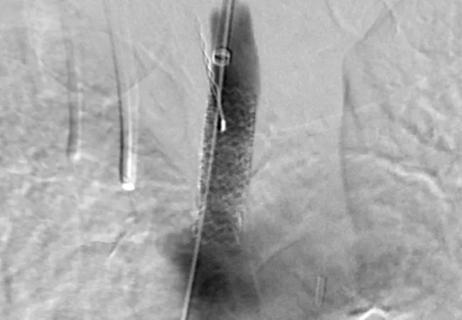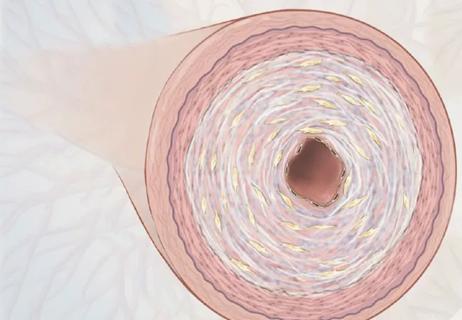Leading aortic and vascular surgeons assess what’s on the horizon

Endovascular therapy is revolutionizing the management of aortic and peripheral vascular diseases. With a better understanding of vascular physiology and increasingly sophisticated designs of stents, grafts and balloons, we can expect that more blood vessels will be opened — as will the door to less invasive options for a wider population of patients.
Advertisement
Cleveland Clinic is a non-profit academic medical center. Advertising on our site helps support our mission. We do not endorse non-Cleveland Clinic products or services. Policy
Consult QD caught up with two Cleveland Clinic surgeons to imagine the near-term future of endovascular therapy from the vantage points of cardio-aortic and vascular surgery. Below are four broad trends they foresee.
Endovascular aneurysm repair has already changed the way aortic aneurysms and dissections are managed, involving less blood loss, shorter operative times and hospital stays, and lower morbidity and mortality. But in cases involving inadequate landing zones, curves or complex vasculature, open repair is usually preferred — if the patient can tolerate it.
“Durability of a graft must always be balanced by considerations of patient tolerability of the procedure,” says Eric Roselli, MD, The Stephens Family Endowed Chair in Cardiothoracic Surgery and Surgical Director of Cleveland Clinic’s Aorta Center. “But expanding indications for endovascular procedures are changing the equation, increasingly giving high-risk patients a chance to receive lifesaving therapy.”
Innovations in stent-graft designs and techniques — including fenestrations, new branch configurations and parallel placements — are opening up endovascular repair of the ascending aorta, aortic arch and thoraco-abdominal aorta, as well as reshaping repair for other complex situations.
Cleveland Clinic is helping advance aortic stent-graft technology on multiple fronts, notably with the MATADORS (Multidisciplinary Study of Ascending Tissue Characteristics and Hemodynamics for the Development of Novel Aortic Stentgrafts) partnership, detailed in a previous Consult QD post. The project — a collaboration among Cleveland Clinic experts, biomedical engineers from device manufacturers, and the FDA — is characterizing the pathogenesis of aortic dissection and aneurysms and defining the boundary conditions for new endovascular device development and testing to treat the ascending aorta.
Advertisement
Cleveland Clinic is also involved in multiple feasibility and pivotal trials testing new stent-graft designs for aortic repair. These include studies of a new disease-specific stent graft from Gore for treating ascending dissections (ARISE trial); the Medtronic Valiant Mona LSA and Gore TBE device trials of single-branched arch stent grafts; a study of the Terumo Aortic double-branched arch device; a trial of Bolton Medical’s Relay®Pro low-profile thoracic stent graft for thoracic aortic dissection; and an investigation of a thoracoabdominal branch endoprosthesis (TAMBE) device from Gore.
“As techniques continue to advance, expect to see equal or better outcomes relative to open repair, as well as increasing use for average-risk patients,” Dr. Roselli adds.
New polymer-based technologies are allowing development of better platforms and coating matrices for drug-eluting stents and balloons, addressing the most frequent cause of failure of any endovascular intervention: restenosis. The cancer drug paclitaxel is increasingly being incorporated into such devices to inhibit cell proliferation and migration after a vessel is opened.
“Drug-eluting stents, long used in cardiac surgery, are being adapted to peripheral artery disease, and multiple trials have already demonstrated good clinical outcomes,” says Sean Lyden, MD, Chairman of Vascular Surgery at Cleveland Clinic. “We expect this area to rapidly expand with more device options and more indications.”
Dr. Lyden is the Cleveland Clinic site lead for the new international clinical trial called SAVAL comparing a drug-eluting stent system versus percutaneous transluminal angioplasty for infrapopliteal artery lesions in patients with critical limb ischemia. “We are also very excited with the data from the recently completed IMPERIAL trial,” he says, noting that the study tested two different paclitaxel-eluting self-expanding stent systems for the superficial femoral and/or proximal popliteal arteries.
Advertisement
Advanced endovascular techniques are making this conventionally open surgery fully percutaneous. After the successful DETOUR I study that used the femoral vein as a conduit for modular stent bypass grafting, Dr. Lyden will be leading the Cleveland Clinic site in the pivotal DETOUR II trial.
He notes that the earlier study showed excellent outcomes for patients with severely calcified or long-segment (lesions > 25 cm) disease. “This procedure gives us a new way to treat patients with very difficult lesions,” he adds.
Some patients have aortic disease involving multiple segments, requiring different interventions. Dr. Roselli says that in such situations, hybrid approaches — combining conventional open surgery and endovascular techniques — will be increasingly used as surgeons become more comfortable with the new strategies. Integrating different procedures in a single operation avoids the additional risk and pain of a multiple-stage operation.
He cites the frozen elephant trunk procedure and novel devices to perform it as examples of innovative solutions for high-risk patients with extensive aortic disease. Such devices that will begin U.S. trials soon include the Terumo Thoraflex™ device (for which study enrollment is completed), the Cryolife EVITA stent graft and the next-generation PHASTER (Proximal Hybrid Aortic Stent graft for Thoracic Extended Repair) device. (Dr. Roselli is the inventor of the PHASTER device.)
Dr. Lyden adds that with the increasing complexity of endovascular procedures, we should also see a trend toward better collaboration between cardiac and vascular surgeons. He notes that it’s common for Cleveland Clinic surgeons of both types to consult — and scrub in — together for a single patient.
Advertisement
“Rather than turf-claiming, it’s important to look at the patient and the disease first and foremost,” he says. “A multidisciplinary approach will usually deliver the best outcome.”
Photo credit: © Russell Lee
Advertisement
Advertisement

How our first century has impacted cardiovascular practice

Review offers comprehensive assessment of the landscape for wearables and more

Preserving trust in research requires vigilance and consensus around statistical nuances

Cardiac surgeon Patrick Vargo, MD, reflects on his first year as Cleveland Clinic staff

Centralization would likely bring better outcomes, experts say, but may not be feasible

JACC review makes the case and outlines how to ensure oversight

Editorial lays out best practices from three Cleveland Clinic surgeons

Cardiac manifestations of this autoimmune disorder can be hidden but deadly